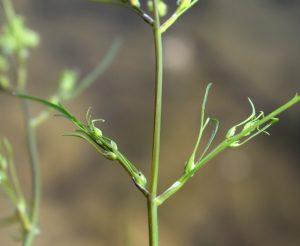Bulblet-bearing Water Hemlock
 Cicuta bulbifera adds to our region’s plentiful group of flora presenting tiny white flowers. Learning to identify this plant is important because it and its cousin, water hemlock (Cicuta maculata), are one of N. America’s most poisonous plants — similar in toxicity to the infamous poison hemlock (Conium maculatum) which is said to have killed Socrates. Minnesota’s two species of water hemlock are both quite common natives to N. America and take their rightful place on this side of the pond. Poison hemlock, on the other hand, is a noxious exotic introduced from Europe that has become so invasive, the MN Dept. of Ag. has listed it as ‘Prohibited/Eradicate’.
Cicuta bulbifera adds to our region’s plentiful group of flora presenting tiny white flowers. Learning to identify this plant is important because it and its cousin, water hemlock (Cicuta maculata), are one of N. America’s most poisonous plants — similar in toxicity to the infamous poison hemlock (Conium maculatum) which is said to have killed Socrates. Minnesota’s two species of water hemlock are both quite common natives to N. America and take their rightful place on this side of the pond. Poison hemlock, on the other hand, is a noxious exotic introduced from Europe that has become so invasive, the MN Dept. of Ag. has listed it as ‘Prohibited/Eradicate’.
Many members of the Carrot family have chemical compounds that make them aromatic and nutritious for humans to eat (dill, carrots, parsley and cilantro to name just a few). Others, however, produce compounds that can lead to toxic effects ranging from dermatitis after brushing skin against the leaves (see parsnip) to death in humans, mammals and songbirds from consuming any of their parts. Into the latter category fall the water hemlocks.

A characteristic that members of the Carrot family share is the arrangement of their flowers which are grouped in clusters called ‘umbels’, meaning their flowers appear on the ends of stalks emanating from a central point — like the ribs of an umbrella. The stems of plants in the Carrot family are also partially hollow, inside of which are the resins and chemicals lending each species their many and varied interesting traits (taste, aroma, toxicity, etc.).
True to its name, bulblet-bearing water hemlock loves water, growing plentifully along lakeshores, in swamps, fens, and slow-moving water. It prefers full sunlight. July through September, look for flowers that are grouped in flat umbels of 15 or so and blooming along Little Bass’s lakeshore and other areas throughout most of Minnesota where this plant can get its feet wet. Note that even though this whole plant can grow 4 feet tall, its various parts are diminutive, making its overall effect spindly in appearance. Leaves grow as slender blades, the flowers with their 5 notched petals are only 1/8″ wide, and the bulblets for which this species is named are also very tiny. Look for the tell-tale bulblets nestled in the leaf axils where they form.
